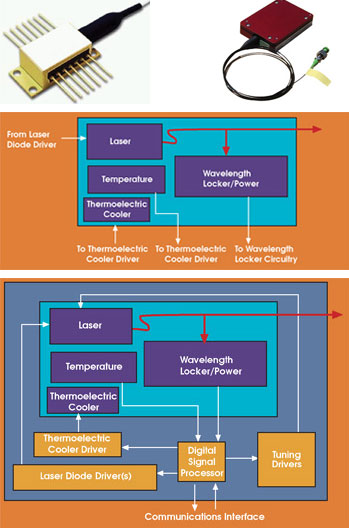Jeff Hutchins, iolon Inc.
In 2001, when the Optical Internetworking Forum (OIF) in Fremont, Calif., began work on a tunable laser implementation agreement, the specifications for commercially available tunable lasers — such as footprints, electrical specifications and interfaces — varied widely because of the different technologies used by vendors. Meanwhile, users of tunable lasers were seeking parts that met a basic set of optical performance specifications and that were available from multiple vendors with a common communications protocol, electrical interface, power supply and mechanical form factor. To resolve this dilemma, the OIF embarked on a series of projects aimed at standardizing tunable lasers.
The first project targeting a standardized platform was the Tunable Laser Implementation Agreement completed in late 2002. This addressed the communications protocol, electrical interface and mechanical form factor to increase interoperability for tunable continuous-wave lasers. Last year, another OIF-sponsored project further enhanced these results with the development of a tunable laser Multisource Implementation Agreement, which has since been supported by a consortium of some 20 tunable laser users and vendors.
Members of OIF demonstrated the interoperability of the communications protocol last year at OFC and at SUPERCOMM.
Optical parameters
Required optical specifications for tunable lasers, including tuning speed and optical performance requirements, are application-dependent. For this reason, optical performance specifications in the multisource agreement are separated into requirements for ultralong-haul, long-haul and metro applications. Fortunately, these application spaces also tend to align with the performance levels of the various tunable laser technologies.
The basic tuning range for each case is approximately 1525 to 1610 nm, which represents the full C- and L-bands. Applications often require tunability of, say, 40 nm, so a single part need not cover the full span. At 20 mW, the fiber output power range will be 13.5 dBm ±0.5 dB, and at 10 mW, 10.5 dBm ±0.5 dB. Output power variation across the tuning range will be a maximum of 0.5 dB.
The following parameters are key differentiators for the metro, long-haul and ultralong-haul application spaces. Obviously, the ultralong-haul applications require the highest performance level.
Specifications
• Spectral linewidth: the 23-dB full width of self-heterodyne measurement using a 3.5-μs delay in one arm of an interferometer. For example, the maximum linewidth is specified as 5 MHz for ultralong-haul, 10 MHz for long-haul and 20 MHz for metro applications.
• Side mode suppression ratio: the ratio of the average CW optical power in the dominant longitudinal mode to the optical power of the most significant side mode in the presence of worst-case reflections. Specified as a minimum ratio, this is set at 43 dB for ultralong-haul and 40 dB for long-haul and metro applications.
• Relative intensity noise. Measured from 10 MHz to 10 GHz, this steps down accordingly for each application category from –145 to –135 dB/Hz and finally to –130 dB/Hz for metro applications.
Tuning speed and other specifications for each application category are further subdivided according to the laser’s role in SONET/SDH protection or restoration, as well as provisioning and sparing.
Both agreements were created with the basic goal of making tunable laser behavior configurable in such a way that it can be used in a number of network equipment manufacturers’ line card architectures and design philosophies (see figure).

The tunable laser multisource agreement also specifies packaging: a common butterfly package (A) and the OIF-compliant tunable module (B).
OIF efforts also are under way to produce some similar performance and mechanical specifications for tunable laser assemblies that can be integrated into a 300-pin transponder as well as a small-form-factor transponder. These are essentially tunable lasers without the case (a standardized board and butterfly package) and a slightly simplified interface. The smaller footprint also facilitates the integration of such tunable devices into nontelecom application areas such as test and measurement.
Meet the author
Jeff Hutchins is editor of the OIF Multisource Implementation Agreement, which is based on the Tunable Laser Implementation Agreement. He also is a senior applications engineering manager at iolon Inc. in San Jose, Calif.; e-mail: [email protected].